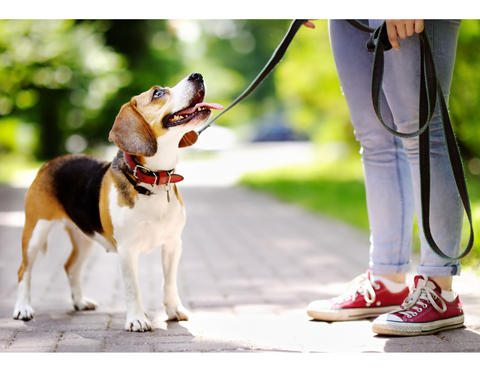Master Leash Training: A Guide for New Dog Owners

Walking with a loose leash is one of the most important skills that you and your dog can learn — but it can also be one of the more challenging skills to train. Leash training helps keep your dog safe, makes walking more enjoyable, and can also strengthen the bond between you and your furry companion.
Here are some tips and tricks to help new dog parents master the art of leash training.
1. Start Early
Leash training requires consistency and patience to master, so it’s important to start as early as possible. Puppies are more adaptable, and establishing good habits early on sets the foundation for a lifetime of positive walking experiences.
But don’t worry: dogs of all ages can learn to walk with a loose leash! If you’re bringing home an older dog, starting their leash training right away can also help establish good habits.
2. Choose the Right Leash and Collar
Select a leash and collar that suits your dog's size and breed, and that will be durable and comfortable for your dog to walk in regularly. Rubyloo’s waterproof (and stink-proof) collars and leashes are a great choice, especially if you plan to take your dog to the beach, park, or other outdoor adventures later.
3. Positive Reinforcement
Use positive reinforcement to encourage good behavior and establish positive associations with your dog’s leash. While walking with your dog, reward them with treats and praise when they walk near you with a loose leash.
When your dog begins to pull, simply stop in your tracks. This helps reinforce that they can get where they want to go, but only when they walk calmly on leash.
4. Short and Sweet Sessions
Avoid overwhelming your dog, especially during the initial stages, by keeping training sessions short and enjoyable. You want to give your dog as many “wins” as possible and avoid making your dog feel frustrated too often.
Start with short sessions with lots of rewards for good behavior, and gradually increase the duration and difficulty as your dog becomes more comfortable with the leash.
5. Practice in a Controlled Environment
If your dog is learning to walk on a leash for the first time, teaching them outside can be distracting. With so many sights and smells to look at, it’s hard for your pup to focus on learning.
When you begin training, start in a quiet and controlled environment to minimize distractions, like inside your home. As your dog becomes more proficient, gradually introduce them to busier areas with more stimuli.
6. Consistency is Key
As your training, be consistent with the commands you use and your expectations for those commands. Use the same signals and words each time you ask for a specific behavior from your dog, such as those for stopping or starting, to help your dog better understand what’s expected of them.
Leash Training Takes Time and Patience
Dogs can be quick learners, but leash training is a big skill that can require lots of time and patience to get right. It’s also a skill that can evolve over time, from simply walking with a loose leash to a more dedicated heel.
By incorporating these tips and tricks, you can help foster a positive walking experience for your pup and help develop skills (and memories) that last a lifetime.

